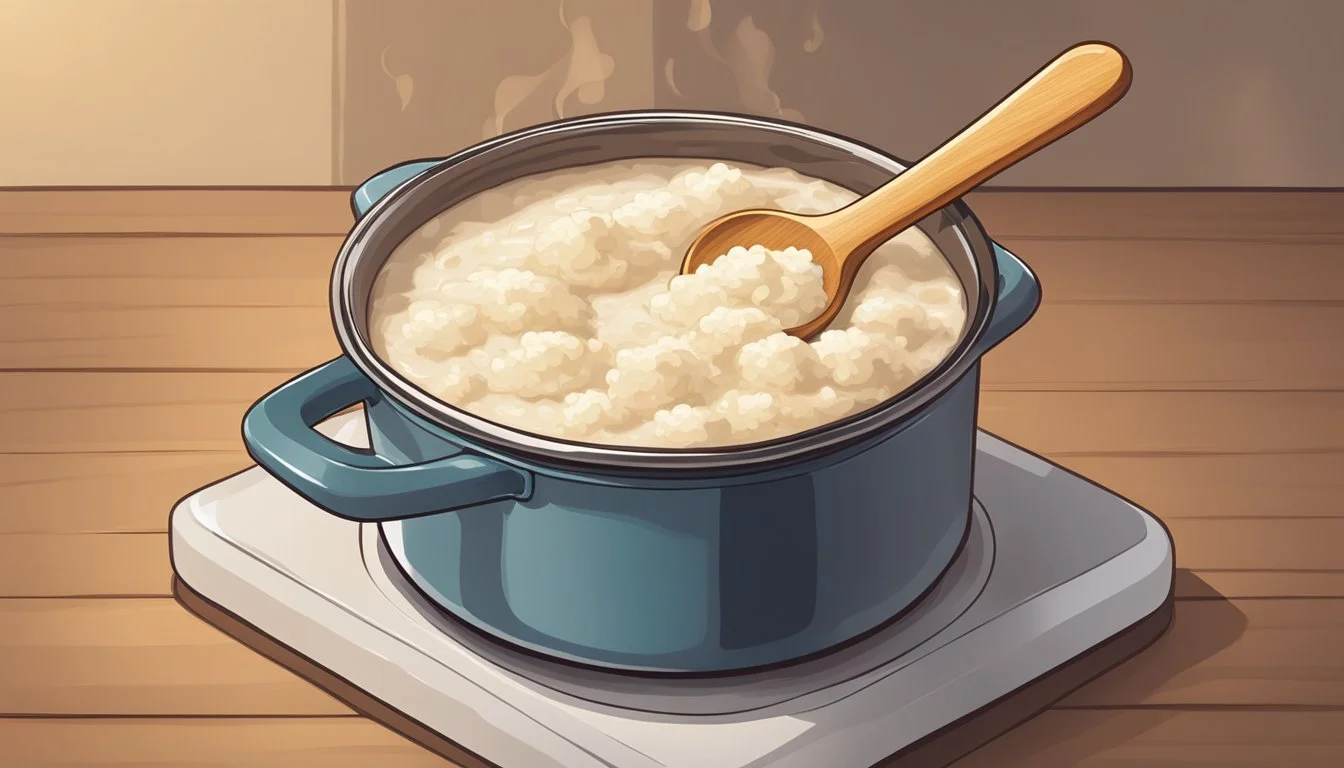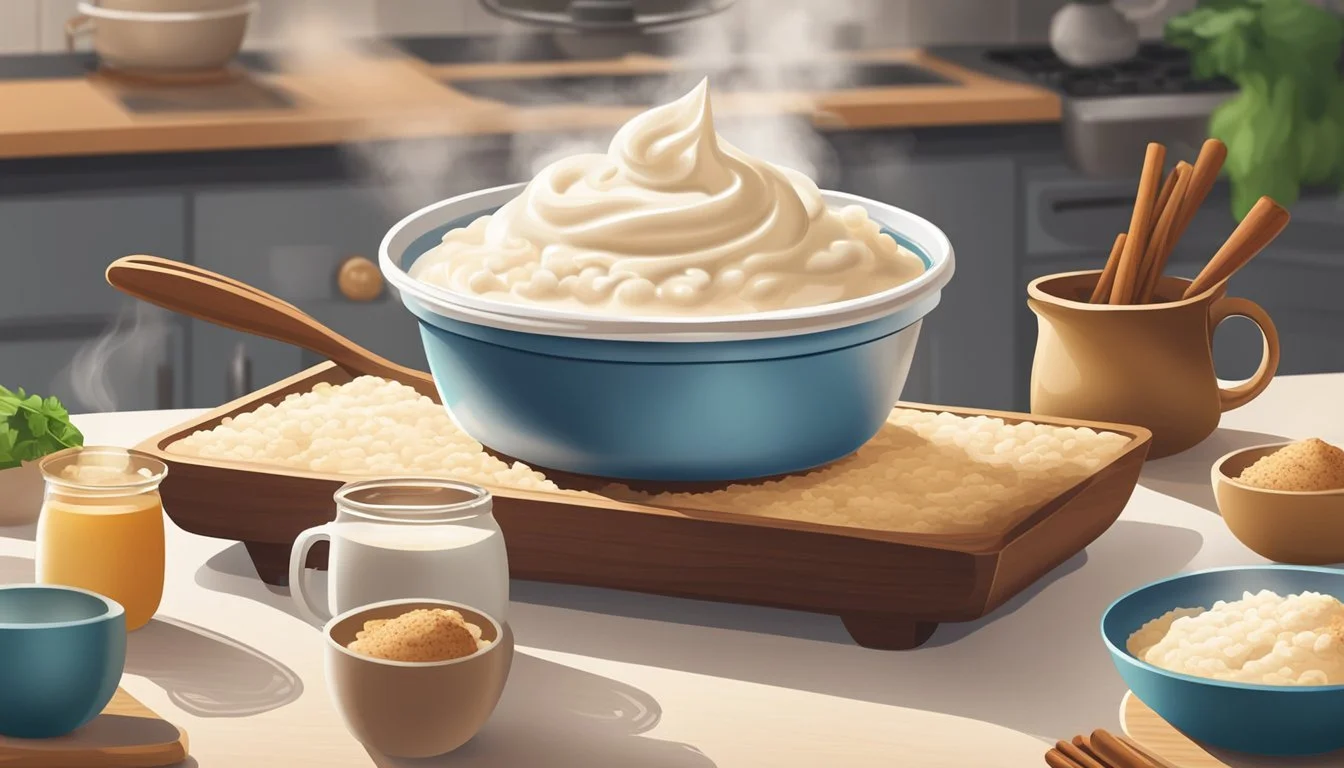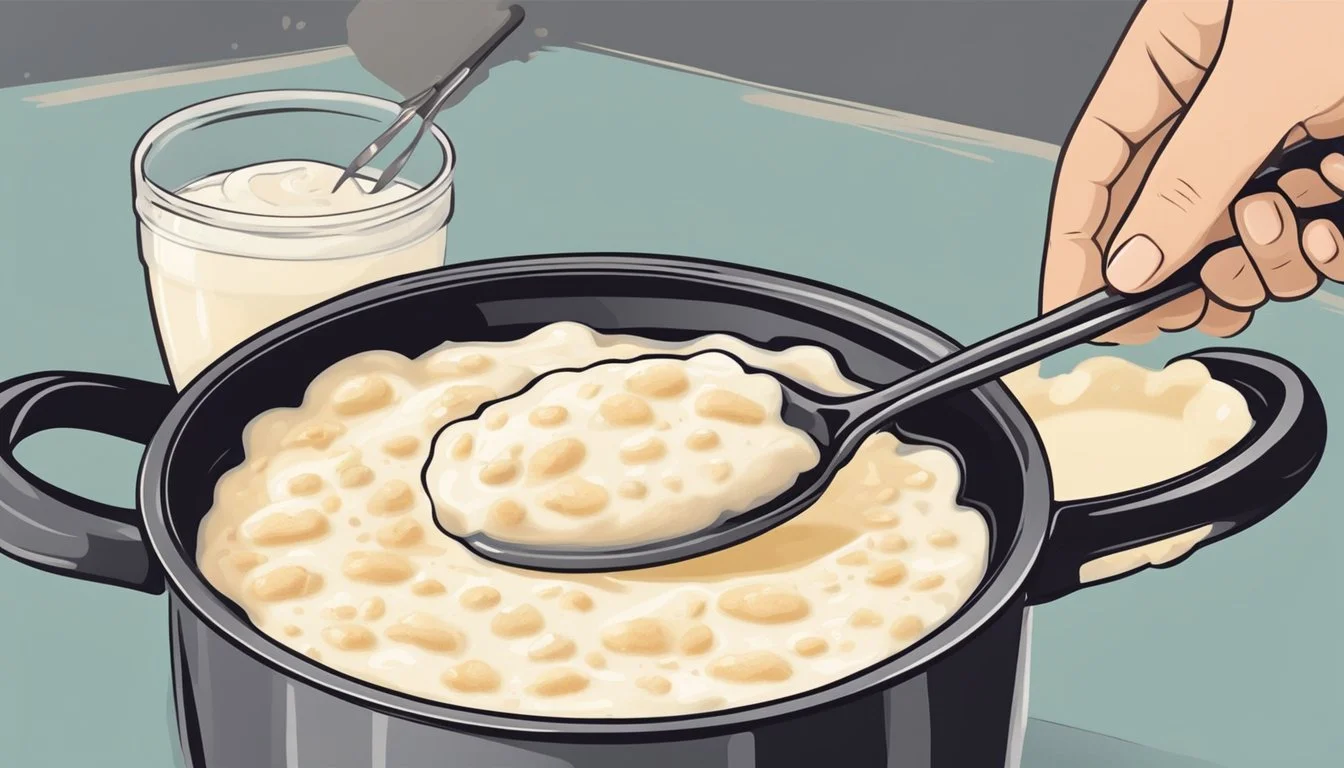Saving Overcooked Rice Pudding
Tips for Reviving Your Dessert
Rice pudding embodies the quintessence of comfort food, with its creamy texture and gentle sweetness offering a soothing balm for the soul. This classic dessert, beloved across various cultures, has stood the test of time, but even the most seasoned cooks can sometimes face the mishap of overcooking. Overcooked rice pudding may appear to be a culinary disaster, with its burnt bottom, overly thick consistency, or dry, mushy grains, yet it is not necessarily beyond redemption.
The key to salvaging overcooked rice pudding lies in understanding the components and the cooking process. Rice pudding typically consists of rice mixed with milk or cream and sugar, gently cooked until the grains become tender and the mixture achieves a velvety richness. When overcooking occurs, it often results in a compromised texture, but with a few clever tweaks and the addition of the right ingredients, it's possible to restore its original charm or even enhance the dish.
Strategies for rescue range from simple additions like a splash of milk or a dollop of cream to counterbalance dryness, to creative repurposing, which can transform the dish into something new and equally palatable. Keeping a keen eye on not deviating from the soul-warming quality of the dessert is paramount. With the right approach, even overcooked rice pudding can remain a delectively creamy and comforting dessert, ready to be enjoyed with renewed appreciation.
The Basics of Rice Pudding
Rice pudding, a classic dessert, stands out for its creamy texture and comforting warmth. This section dissects the fundamental components that make up this beloved treat.
What Is Rice Pudding?
Rice pudding is a dessert made from rice mixed with water or milk and other ingredients such as cinnamon and sugar. It can be served hot or cold, and is frequently flavored with vanilla, cinnamon, and occasionally raisins. Known for its simplicity and versatility, rice pudding is often regarded as a quintessential comfort food.
Essential Ingredients
The concoction of rice pudding is rooted in its essential ingredients. The recipe typically calls for:
Rice: Short-grain or long-grain white rice is the base. Short-grain rice tends to create a creamier pudding.
Milk: Whole milk is commonly used to provide a rich taste and creamy texture; however, some recipes may use a combination of milk and cream.
Sugar: Granulated sugar sweetens the dish, with the amount adjusted according to taste.
Flavorings:
Vanilla extract: A touch of vanilla extract adds a warm, aromatic flavor.
Cinnamon: Often sprinkled on top or mixed in for a spicy depth of flavor.
Salt: A pinch of salt is crucial to balance the sweetness.
Ingredient Role Rice Provides structure and texture Milk/Cream Adds creaminess and serves as the cooking liquid Sugar Sweetens the dessert Cinnamon Offers a warm, spicy note Vanilla Extract Infuses the pudding with a subtle, aromatic flavor Salt Enhances and balances the flavors
The simplicity of the ingredients allows for countless variations and the flexibility to rescue an overcooked dish by adjusting the creamy elements or adding flavorings.
Classic Rice Pudding Recipe
This Classic Rice Pudding Recipe provides a blueprint for a creamy, comforting dessert. With precise cook times and a focus on technique, one can achieve the perfect texture and flavor.
Step-by-Step Instructions
Prep: Begin by gathering all the necessary ingredients for a classic rice pudding: short-grain rice, milk, sugar, and cinnamon. To ensure a smooth process, one should measure out each component before cooking.
Combine Ingredients: In a heavy-bottomed saucepan, mix together one cup of cooked short-grain rice with 1 1/2 cups of milk, a pinch of salt, and a generous amount of sugar to taste.
Start Cooking: Place the saucepan on the stovetop over medium heat and stir the mixture continuously to prevent sticking and burning.
Simmer: Once the mixture has heated thoroughly, reduce the heat to low and let the pudding simmer for approximately 15 minutes. The key is to watch for a thick, creamy texture to develop.
Final Touches: After achieving the desired consistency, stir in an additional 1/2 cup of milk along with any desired dried fruits (What wine goes well with dried fruits?) such as raisins. Next, incorporate a beaten egg into the mixture, making sure to stir continuously for 2 more minutes to avoid curdling.
Season: To finish, one may flavor the pudding with cinnamon and nutmeg for warmth and depth, stirring these into the mixture just before removing it from heat.
Proper Cooking Techniques
Continuous Stirring: This is crucial for the prevention of lumps and burning, yielding a creamy and smooth pudding.
Gentle Simmer: A controlled and gentle simmer ensures that the rice slowly absorbs the flavors without becoming mushy.
Temperature Control: To incorporate eggs without cooking them instantly, one must temper the egg by adding a small amount of the hot mixture into the egg first, then gradually whisking them back into the pot.
Texture Watch: The pudding's consistency is best when it coats the back of a spoon. One should remove the pudding from the heat when it's slightly looser than desired; it will continue to thicken as it cools.
Following a meticulous approach to these instructions and techniques ensures an indulgent and satisfying classic rice pudding.
Variations and Add-Ins
Adapting overcooked rice pudding into a delightful dessert is straightforward with the right add-ins and variations. Enhancements not only revive the dish but also cater to diverse dietary needs and taste preferences.
Creative Flavor Twists
To reimagine the rice pudding, infusing new flavors can greatly enhance its appeal:
Fruits: Fresh fruit can brighten up the pudding, with poached pears or apple compote being excellent choices.
Dried Fruit and Nuts: Incorporate raisins, dried cranberries, or a mix of nuts for added texture and flavor.
Seasonings: A dash of cinnamon, vanilla, or nutmeg can introduce warm notes that complement the creamy backdrop of the pudding.
Dietary Adjustments
The recipe can be tailored to various dietary requirements without sacrificing taste:
Alternative Milks: Substituting cow's milk with alternative milks like almond, soy, or coconut milk can make the dish suitable for dairy-free and vegan diets.
Rice Alternatives: Using leftover rice from other meals can be both economical and a clever twist to the classic pudding recipe.
Sweeteners: Consider sweeteners like maple syrup or honey to diversify the taste profile for those looking to explore beyond traditional sugar.
Through these adjustments and add-ins, rice pudding becomes a versatile dessert that can please an array of palates and adhere to different dietary considerations.
Fixing Overcooked Rice Pudding
When rice pudding ends up overcooked, it often loses its desired creamy consistency. This section offers practical solutions to reintroduce creaminess and the right reheating methods to revive the texture.
Adding Creaminess Back
To restore creaminess to overcooked rice pudding, one can consider incorporating dairy products like cream, whole milk, or butter. These ingredients add moisture and a rich taste, countering the effects of overcooking.
Whole Milk: Gently stir in small amounts of whole milk until the desired consistency is achieved.
Heavy Cream: For a richer texture, a few tablespoons of heavy cream can be blended into the pudding.
Butter: A knob of butter melted into the rice pudding can bring back a velvety texture.
Adjust the amount of dairy added according to personal preference and the degree of dryness of the pudding.
Reheating Techniques
Proper reheating can also help in reviving the texture of overcooked rice pudding. There are two main methods: on the stovetop and in the oven.
Stovetop:
Place rice pudding in a saucepan.
Add a splash of milk or cream.
Heat on medium-low, stirring frequently to prevent sticking.
Oven:
Preheat the oven to 250°F (120°C).
Spread the rice pudding evenly on a baking sheet.
Warm for 10-15 minutes, checking occasionally to ensure it does not dry out.
Both reheating techniques can help redistribute moisture and heat throughout the pudding, improving its texture.
Serving and Presentation
When one serves rice pudding, the focus is on enhancing its creamy texture and flavor complexity through the judicious use of toppings and pairing with compatible desserts. Presentation should both entice the senses and complement the inherent comfort of the dish.
Suggested Toppings and Garnishes
To elevate the creamy delight of rice pudding, consider a selection of toppings and garnishes that add both texture and bursts of flavor.
Cinnamon: A dusting of cinnamon adds warmth and spice.
Whipped Cream: A dollop of whipped cream introduces a light and airy contrast.
Granulated Sugar: A sprinkle can contribute a subtle crunch.
Fruit: Fresh fruit like berries or a compote can provide a tart balance.
Raisins: Stirred in or sprinkled on top to introduce a chewy sweetness.
Vanilla: A drizzle of high-quality vanilla extract or scrapings from a vanilla bean pod can infuse the pudding with a rich aroma and taste.
Pairing with Other Desserts
Rice pudding can stand on its own, but it also pairs harmoniously with other desserts to create a more rounded experience.
Vanilla Ice Cream: Offering vanilla ice cream alongside rice pudding combines two creamy textures.
Bread Pudding: For those who indulge in a duo of comfort desserts, bread pudding complements rice pudding well, varying texture while maintaining a similar flavor profile.
In serving, one should ensure the rice pudding is at a desirable temperature and consider the balance of flavors and textures with chosen toppings and pairings. The presentation should be as comforting as the dessert itself, inviting with its simplicity and homage to classic dessert traditions.
Nutritional Information
In discussing the nutritional aspects of repurposing overcooked rice pudding, one must consider the caloric and nutritional content of the dish. Rice pudding's sweet flavor comes primarily from its carbohydrate and sugar content, which play a central role in contributing to the overall calorie count.
Caloric and Nutritional Content
Rice pudding is a carbohydrate-rich dessert, with sugars being a significant contributor to its calorie content. A typical serving of rice pudding can contain:
Calories: Generally, a 1-cup serving contains approximately 200 to 300 calories, depending on the specific recipe and ingredients used.
Carbohydrates: This same serving size can deliver about 30 to 40 grams of carbohydrates.
Sugars: Given the sugar content that lends the dessert its characteristic sweetness, one can expect a range between 20 to 30 grams per serving.
The nutritional value of rice pudding goes beyond calories and carbohydrates. It also contains proteins and vitamins contributing to its overall nutritional profile. However, the exact nutritional content can vary widely based on additions or substitutions in the recipe, such as the use of alternative sweeteners or dairy products.
Storage and Preservation
Proper storage extends the life of leftover rice pudding, ensuring it remains creamy and flavorful. Understanding how to store leftovers and the best practices for freezing and thawing allows individuals to enjoy this dessert at a later time without compromising quality.
How to Store Leftovers
Leftovers should be cooled to room temperature before storing to prevent bacterial growth. Once cooled, the rice pudding can be transferred to an airtight container and refrigerated. Rice pudding should be consumed within 5 days when stored in the fridge to maintain its taste and texture.
Best Practices for Freezing and Thawing
Rice pudding can be frozen for longer preservation. To freeze, divide the pudding into portion-sized containers or bags, leaving some space to accommodate expansion:
To Freeze:
Cool the pudding to room temperature.
Place in airtight containers or heavy-duty freezer bags.
Label the containers with the current date.
Freeze for up to 1 month for best quality.
To Thaw:
Transfer the frozen rice pudding to the refrigerator the night before it's intended to be eaten.
Slow thawing prevents sudden temperature changes that can affect texture.
To reheat, gently warm the pudding on the stove over low heat, stirring frequently, or in the microwave in short intervals, stirring between each to ensure even heating. Do not refreeze previously frozen rice pudding.
Advanced Tips and Techniques
When it comes to rescuing overcooked rice pudding, the key lies in understanding how to manipulate texture and flavor. With the right techniques, one can transform a less-than-ideal batch into a dish that's both comforting and indulgent.
Achieving the Perfect Creamy Texture
The texture of rice pudding hinges on the starch from the rice and the presence of dairy. To counteract overcooking, they can introduce an appropriate dairy product such as whole milk which can replenish moisture and enhance creaminess. Here's how to do it:
Simmer: Return the pudding to a gentle simmer, not a boil, which can further denature proteins and make the mixture too thick.
Stir: Continual stirring is essential. This prevents the rice from settling at the bottom and promotes even rehydration and distribution of starches.
Dairy Addition: Gradually add small amounts of whole milk while stirring. Since whole milk is rich in fat, it will contribute to a richer, creamier texture that rescues overcooked grains.
Enhancing Flavor Profiles
Flavor can be just as important as texture. If the rice pudding is overcooked, the flavors may have diminished or changed negatively. To enhance and correct the flavor profile, consider the following:
Sugar: Add sugar sparingly to taste, as it can help balance out any bitterness that may have resulted from overcooking.
Vanilla: Vanilla is a classic flavor enhancer. Incorporate real vanilla extract or paste to introduce warm, complex notes.
Cinnamon: A pinch of cinnamon can contribute a subtle spiciness and warmth that complements the creamy sweetness of the pudding.
Flavor Pairing: Consider complementary flavors such as a splash of rose water for a floral note or cardamom for an exotic twist.
By careful adjustment of ingredients like whole milk, vanilla, and cinnamon, and by using techniques like simmering and stirring, they can ensure an even, creamy texture and a balanced flavor profile in their rice pudding, even if it was initially overcooked.










